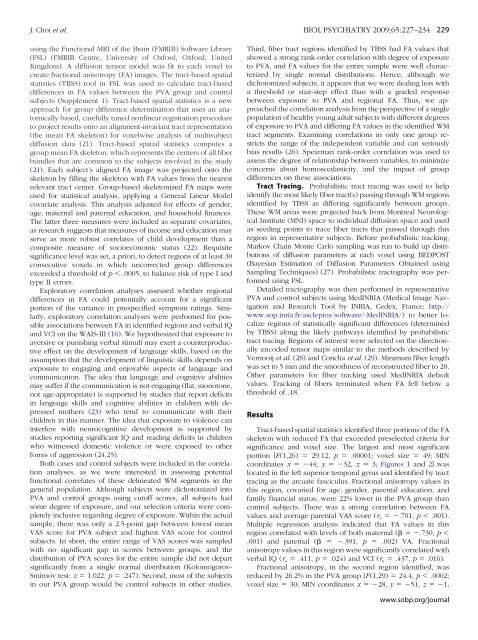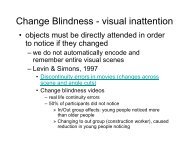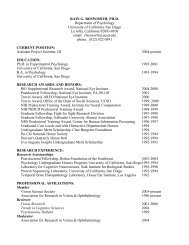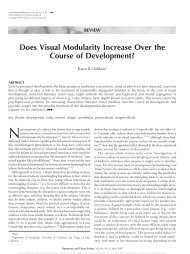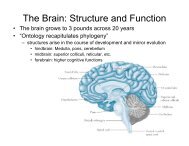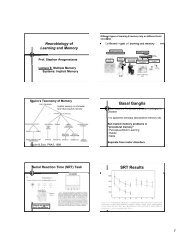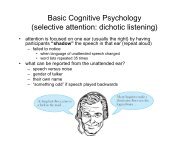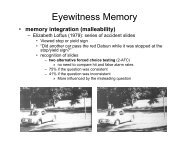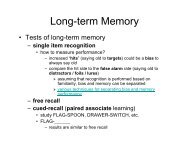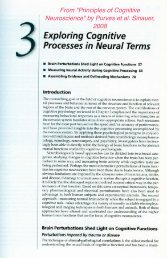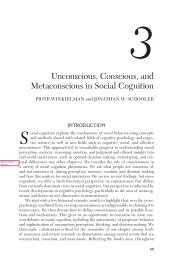Preliminary Evidence for White Matter Tract Abnormalities in Young ...
Preliminary Evidence for White Matter Tract Abnormalities in Young ...
Preliminary Evidence for White Matter Tract Abnormalities in Young ...
Create successful ePaper yourself
Turn your PDF publications into a flip-book with our unique Google optimized e-Paper software.
J. Choi et al. BIOL PSYCHIATRY 2009;65:227–234 229<br />
us<strong>in</strong>g the Functional MRI of the Bra<strong>in</strong> (FMRIB) Software Library<br />
(FSL) (FMRIB Centre, University of Ox<strong>for</strong>d, Ox<strong>for</strong>d, United<br />
K<strong>in</strong>gdom). A diffusion tensor model was fit to each voxel to<br />
create fractional anisotropy (FA) images. The tract-based spatial<br />
statistics (TBSS) tool <strong>in</strong> FSL was used to calculate tract-based<br />
differences <strong>in</strong> FA values between the PVA group and control<br />
subjects (Supplement 1). <strong>Tract</strong>-based spatial statistics is a new<br />
approach <strong>for</strong> group difference determ<strong>in</strong>ation that uses an anatomically<br />
based, carefully tuned nonl<strong>in</strong>ear registration procedure<br />
to project results onto an alignment-<strong>in</strong>variant tract representation<br />
(the mean FA skeleton) <strong>for</strong> voxelwise analysis of multisubject<br />
diffusion data (21). <strong>Tract</strong>-based spatial statistics computes a<br />
group mean FA skeleton, which represents the centers of all fiber<br />
bundles that are common to the subjects <strong>in</strong>volved <strong>in</strong> the study<br />
(21). Each subject’s aligned FA image was projected onto the<br />
skeleton by fill<strong>in</strong>g the skeleton with FA values from the nearest<br />
relevant tract center. Group-based skeletonized FA maps were<br />
used <strong>for</strong> statistical analysis, apply<strong>in</strong>g a General L<strong>in</strong>ear Model<br />
covariate analysis. This analysis adjusted <strong>for</strong> effects of gender,<br />
age, maternal and paternal education, and household f<strong>in</strong>ances.<br />
The latter three measures were <strong>in</strong>cluded as separate covariates,<br />
as research suggests that measures of <strong>in</strong>come and education may<br />
serve as more robust correlates of child development than a<br />
composite measure of socioeconomic status (22). Requisite<br />
significance level was set, a priori, to detect regions of at least 30<br />
consecutive voxels <strong>in</strong> which uncorrected group differences<br />
exceeded a threshold of p .0005, to balance risk of type I and<br />
type II errors.<br />
Exploratory correlation analyses assessed whether regional<br />
differences <strong>in</strong> FA could potentially account <strong>for</strong> a significant<br />
portion of the variance <strong>in</strong> prespecified symptom rat<strong>in</strong>gs. Similarly,<br />
exploratory correlation analyses were per<strong>for</strong>med <strong>for</strong> possible<br />
associations between FA <strong>in</strong> identified regions and verbal IQ<br />
and VCI on the WAIS-III (16). We hypothesized that exposure to<br />
aversive or punish<strong>in</strong>g verbal stimuli may exert a counterproductive<br />
effect on the development of language skills, based on the<br />
assumption that the development of l<strong>in</strong>guistic skills depends on<br />
exposure to engag<strong>in</strong>g and enjoyable aspects of language and<br />
communication. The idea that language and cognitive abilities<br />
may suffer if the communication is not engag<strong>in</strong>g (flat, monotone,<br />
not age-appropriate) is supported by studies that report deficits<br />
<strong>in</strong> language skills and cognitive abilities <strong>in</strong> children with depressed<br />
mothers (23) who tend to communicate with their<br />
children <strong>in</strong> this manner. The idea that exposure to violence can<br />
<strong>in</strong>terfere with neurocognitive development is supported by<br />
studies report<strong>in</strong>g significant IQ and read<strong>in</strong>g deficits <strong>in</strong> children<br />
who witnessed domestic violence or were exposed to other<br />
<strong>for</strong>ms of aggression (24,25).<br />
Both cases and control subjects were <strong>in</strong>cluded <strong>in</strong> the correlation<br />
analyses, as we were <strong>in</strong>terested <strong>in</strong> assess<strong>in</strong>g potential<br />
functional correlates of these del<strong>in</strong>eated WM segments <strong>in</strong> the<br />
general population. Although subjects were dichotomized <strong>in</strong>to<br />
PVA and control groups us<strong>in</strong>g cutoff scores, all subjects had<br />
some degree of exposure, and our selection criteria were completely<br />
<strong>in</strong>clusive regard<strong>in</strong>g degree of exposure. With<strong>in</strong> the actual<br />
sample, there was only a 2.5-po<strong>in</strong>t gap between lowest mean<br />
VAS score <strong>for</strong> PVA subject and highest VAS score <strong>for</strong> control<br />
subjects. In short, the entire range of VAS scores was sampled<br />
with no significant gap <strong>in</strong> scores between groups, and the<br />
distribution of PVA scores <strong>for</strong> the entire sample did not depart<br />
significantly from a s<strong>in</strong>gle normal distribution (Kolomogorov-<br />
Smirnov test: z 1.022, p .247). Second, most of the subjects<br />
<strong>in</strong> our PVA group would be control subjects <strong>in</strong> other studies.<br />
Third, fiber tract regions identified by TBSS had FA values that<br />
showed a strong rank-order correlation with degree of exposure<br />
to PVA, and FA values <strong>for</strong> the entire sample were well characterized<br />
by s<strong>in</strong>gle normal distributions. Hence, although we<br />
dichotomized subjects, it appears that we were deal<strong>in</strong>g less with<br />
a threshold or stair-step effect than with a graded response<br />
between exposure to PVA and regional FA. Thus, we approached<br />
the correlation analysis from the perspective of a s<strong>in</strong>gle<br />
population of healthy young adult subjects with different degrees<br />
of exposure to PVA and differ<strong>in</strong>g FA values <strong>in</strong> the identified WM<br />
tract segments. Exam<strong>in</strong><strong>in</strong>g correlations <strong>in</strong> only one group restricts<br />
the range of the <strong>in</strong>dependent variable and can seriously<br />
bias results (26). Spearman rank-order correlation was used to<br />
assess the degree of relationship between variables, to m<strong>in</strong>imize<br />
concerns about homoscedasticity, and the impact of group<br />
differences on these associations.<br />
<strong>Tract</strong> Trac<strong>in</strong>g. Probabilistic tract trac<strong>in</strong>g was used to help<br />
identify the most likely fiber tract(s) pass<strong>in</strong>g through WM regions<br />
identified by TBSS as differ<strong>in</strong>g significantly between groups.<br />
These WM areas were projected back from Montreal Neurological<br />
Institute (MNI) space to <strong>in</strong>dividual diffusion space and used<br />
as seed<strong>in</strong>g po<strong>in</strong>ts to trace fiber tracts that passed through this<br />
region <strong>in</strong> representative subjects. Be<strong>for</strong>e probabilistic track<strong>in</strong>g,<br />
Markov Cha<strong>in</strong> Monte Carlo sampl<strong>in</strong>g was run to build up distributions<br />
of diffusion parameters at each voxel us<strong>in</strong>g BEDPOST<br />
(Bayesian Estimation of Diffusion Parameters Obta<strong>in</strong>ed us<strong>in</strong>g<br />
Sampl<strong>in</strong>g Techniques) (27). Probabilistic tractography was per<strong>for</strong>med<br />
us<strong>in</strong>g FSL.<br />
Detailed tractography was then per<strong>for</strong>med <strong>in</strong> representative<br />
PVA and control subjects us<strong>in</strong>g MedINRIA (Medical Image Navigation<br />
and Research Tool by INRIA, Cedex, France; http://<br />
www.sop.<strong>in</strong>ria.fr/asclepios/software/-MedINRIA/) to better localize<br />
regions of statistically significant differences (determ<strong>in</strong>ed<br />
by TBSS) along the likely pathways identified by probabilistic<br />
tract trac<strong>in</strong>g. Regions of <strong>in</strong>terest were selected on the directionally<br />
encoded tensor maps similar to the methods described by<br />
Vernooij et al. (28) and Concha et al. (29). M<strong>in</strong>imum fiber length<br />
was set to 5 mm and the smoothness of reconstructed fiber to 20.<br />
Other parameters <strong>for</strong> fiber track<strong>in</strong>g used MedINRIA default<br />
values. Track<strong>in</strong>g of fibers term<strong>in</strong>ated when FA fell below a<br />
threshold of .18.<br />
Results<br />
<strong>Tract</strong>-based spatial statistics identified three portions of the FA<br />
skeleton with reduced FA that exceeded preselected criteria <strong>for</strong><br />
significance and voxel size. The largest and most significant<br />
portion [F(1,26) 29.12, p .00001; voxel size 49; MIN<br />
coord<strong>in</strong>ates x 44, y 32, z 3; Figures 1 and 2] was<br />
located <strong>in</strong> the left superior temporal gyrus and identified by tract<br />
trac<strong>in</strong>g as the arcuate fasciculus. Fractional anisotropy values <strong>in</strong><br />
this region, covaried <strong>for</strong> age, gender, parental education, and<br />
family f<strong>in</strong>ancial status, were 22% lower <strong>in</strong> the PVA group than<br />
control subjects. There was a strong correlation between FA<br />
values and average parental VAS score (r s .701, p .001).<br />
Multiple regression analysis <strong>in</strong>dicated that FA values <strong>in</strong> this<br />
region correlated with levels of both maternal ( .730, p <br />
.001) and paternal ( .391, p .002) VA. Fractional<br />
anisotropy values <strong>in</strong> this region were significantly correlated with<br />
verbal IQ (r s .411, p .024) and VCI (r s .437, p .016).<br />
Fractional anisotropy, <strong>in</strong> the second region identified, was<br />
reduced by 26.2% <strong>in</strong> the PVA group [F(1,29) 24.4, p .0002;<br />
voxel size 30; MIN coord<strong>in</strong>ates x 28, y 51, z 1;<br />
www.sobp.org/journal


